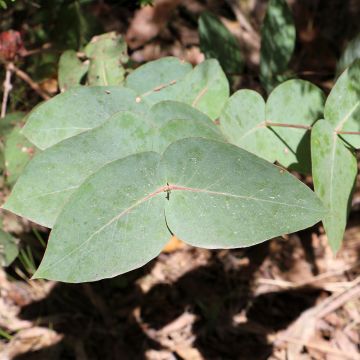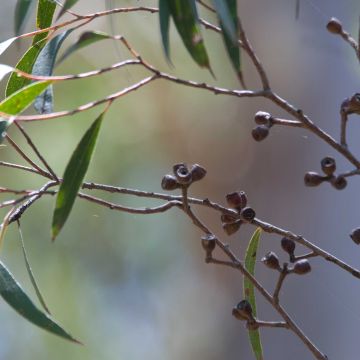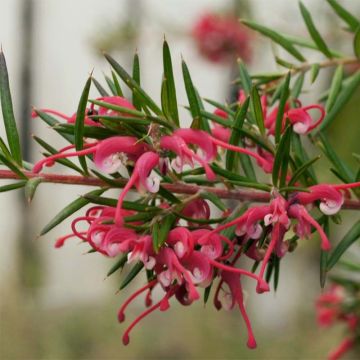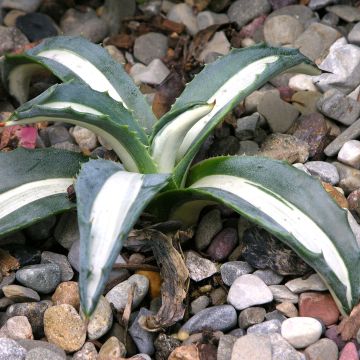

Eucalyptus pauciflora subsp. pauciflora Adaminaby
Eucalyptus pauciflora subsp. pauciflora Adaminaby
Eucalyptus pauciflora subsp. pauciflora Adaminaby
Snow Gum
This item cannot be shipped to the selected country
Delivery charge from €5.90
More information
Schedule delivery date,
and select date in basket
This plant carries a 24 months recovery warranty
More information
We guarantee the quality of our plants for a full growing cycle, and will replace at our expense any plant that fails to recover under normal climatic and planting conditions.
From €5.90 for pickup delivery and €6.90 for home delivery
Express home delivery from €8.90.
Does this plant fit my garden?
Set up your Plantfit profile →
Description
Eucalyptus pauciflora subsp. pauciflora 'Adaminaby' is a Snow Gum native to southern Australia. It forms a medium-sized tree, occasionally taller, and sometimes a large bush with multiple trunks. Particularly appreciated for its highly ornamental bark, where grey, white and cream mingle, it adopts a slender habit, forming a more or less rounded crown. Its juvenile foliage is also attractive, with its leaves of a pretty bluish-green. The white flowering in small pompoms, which stand out well on the darker foliage, is a further asset for this species. Growing in acidic, neutral or slightly chalky soils, it is moderately hardy and should be planted in a sunny exposure.
The Eucalyptus is a tree of the Myrtaceae family, like the Feijoa, the Callistemon or the Myrtle, with the characteristic flowering of this family. The Eucalyptus genus, bound to Australia, except for a few rare species from Southeast Asia, has more than 800 species, among which are the tallest leafy trees in the world (E. regnans), but also medium-sized bushes. Eucalyptus pauciflora subsp. pauciflora grows naturally in a very large geographical area, extending from southeast Queensland, covering the east of New South Wales to the state of Victoria and Tasmania. This wide dispersion has generated different forms, often named after their locality or region of origin. Adaminaby is a small locality situated more than 1000 m (3280 ft 10 in) above sea level in the Snowy Mountains, south of the capital Canberra. This Snow Gum is exposed to a contrasting climate, mild to hot in summer, becoming cold and snowy in winter.
This species forms a tree, or a mallee, an aboriginal term for a ramified bush from the base measuring less than 10 m (32 ft 10 in), usually 5 to 6 m (16 ft 5 in to 19 ft 8 in). The tree form can reach up to 30 m (98 ft 5 in) high and nearly 20 m (65 ft 7 in) wide, while under our latitudes, it will peak between 12 to 15 m (39 ft 5 in to 49 ft 2 in) in height, and a spread of about 8 m. The trunk is dressed in a very ornamental smooth bark, predominantly in shades of white, cream and grey, with yellow inserts. This Eucalyptus presents a significant regeneration capacity thanks to its lignotuber. It is an underground swelling rich in starch, capable of emitting many shoots if the aerial part of the plant is destroyed (typically by a fire). The regrowth is bushier than the original plant after this pruning. This characteristic possessed by many Eucalyptus is particularly interesting from an ornamental point of view, as it allows severe prunings, which allows you to limit the development of the plant, to make it branch well and finally stimulate the formation of juvenile foliage, which in many species, is more decorative than the adult foliage. This is the case with Adaminaby, where it has a lanceolate to elliptical shape, of a glaucous and matt bluish green. These juvenile leaves measure from 4.5 to 17 cm (1.8 to 6.7 in) long and 2 to 8.5 cm (0.8 to 3.3 in) wide, and are sessile. The adult foliage is a little larger, lanceolate to crescent-shaped, measuring up to 20 cm (7.9 in) in length and 5 cm (2 in) in width. It takes on a slightly shiny green colour and gives off a pleasant eucalyptol smell when crushed, due to the presence of glands rich in essential oils.
Belying its species name (pauciflora means "which bears few flowers"), this Eucalyptus displays a particularly abundant and decorative flowering, in the form of white pompoms that contrast well with the darker vegetation. Axillary umbels gather from 9 to 15 flowers (and sometimes significantly more) that display spreading stamens in all directions, making one forget the absence of petals. This flowering usually occurs between October and February in our climates and anytime during the year in Australia. It is followed by small cup-shaped fruits devoid of ornamental interest.
Growing in full sun, this tree develops in acidic to neutral soils, tolerating a bit of lime. It likes moist, but well-drained soils and tolerates dryness relatively well once established. Its mountain origin allows it to resist temperatures down to -10°C (14 °F) to -12°C (10.4 °F) under good conditions, and of course, it does not mind snow.
Eucalyptus pauciflora subsp. pauciflora 'Adaminaby' is an interesting species for its exotic aspect, its beautiful bark and its delightful flowering. Originally from regions without a marked dry season, it will be at ease in a warmer coastal climate and can also adapt in the not-too-dry areas of the south. In a mild climate, plant at its feet a Pittosporum tenuifolium Purpureum, a small bush with undulate purple foliage that will contrast pleasantly with the light bark and green or bluish foliage. Eucryphia lucida Gilt Edge, a beautiful bush with evergreen foliage, finely variegated with yellow, with a long-lasting white flowering in summer and well adapted to mild oceanic climates, will also be a perfect companion for your Eucalyptus. To enjoy a delightful spring flowering in pink, complete this scene with Magnolia Fairy Blush, a Michelia hybrid with an exotic aspect with its dense vegetation of dark green and the soft scent of its elaborate flowers.
Report an error about the product description
Eucalyptus pauciflora subsp. pauciflora Adaminaby in pictures


Plant habit
Flowering
Foliage
Botanical data
Eucalyptus
pauciflora subsp. pauciflora
Adaminaby
Myrtaceae
Snow Gum
Australia
Other Eucalyptus
Planting and care
Eucalyptus pauciflora subsp. pauciflora 'Adaminaby' is best planted at the beginning of spring in cold regions, after the last late frosts, in early autumn in a hot climate, to take advantage of winter precipitation. Install it in well-drained, moist or occasionally dry soil without too much limestone, in a warm and sunny situation. It is hardy down to -10°C/-12 °C (10.4 °F) under these conditions, once mature. In many regions, you can plant it in the open ground, ensuring good drainage by adding coarse sand, pozzolana or non-limestone gravel. Water for the first two years, then the bush generally requires no watering in summer, except in the driest regions. Fertiliser is discouraged. Pruning is well tolerated, after flowering, but not necessary unless you want to rebalance its shape or limit its development.
Gum trees are useful for drying out wet lands, as they are large consumers of water even in winter. However, they are quite resistant to drought once well established (depending on the variety).
Planting period
Intended location
Care
This item has not been reviewed yet - be the first to leave a review about it.
Evergreen shrubs
Haven't found what you were looking for?
Hardiness is the lowest winter temperature a plant can endure without suffering serious damage or even dying. However, hardiness is affected by location (a sheltered area, such as a patio), protection (winter cover) and soil type (hardiness is improved by well-drained soil).

Photo Sharing Terms & Conditions
In order to encourage gardeners to interact and share their experiences, Promesse de fleurs offers various media enabling content to be uploaded onto its Site - in particular via the ‘Photo sharing’ module.
The User agrees to refrain from:
- Posting any content that is illegal, prejudicial, insulting, racist, inciteful to hatred, revisionist, contrary to public decency, that infringes on privacy or on the privacy rights of third parties, in particular the publicity rights of persons and goods, intellectual property rights, or the right to privacy.
- Submitting content on behalf of a third party;
- Impersonate the identity of a third party and/or publish any personal information about a third party;
In general, the User undertakes to refrain from any unethical behaviour.
All Content (in particular text, comments, files, images, photos, videos, creative works, etc.), which may be subject to property or intellectual property rights, image or other private rights, shall remain the property of the User, subject to the limited rights granted by the terms of the licence granted by Promesse de fleurs as stated below. Users are at liberty to publish or not to publish such Content on the Site, notably via the ‘Photo Sharing’ facility, and accept that this Content shall be made public and freely accessible, notably on the Internet.
Users further acknowledge, undertake to have ,and guarantee that they hold all necessary rights and permissions to publish such material on the Site, in particular with regard to the legislation in force pertaining to any privacy, property, intellectual property, image, or contractual rights, or rights of any other nature. By publishing such Content on the Site, Users acknowledge accepting full liability as publishers of the Content within the meaning of the law, and grant Promesse de fleurs, free of charge, an inclusive, worldwide licence for the said Content for the entire duration of its publication, including all reproduction, representation, up/downloading, displaying, performing, transmission, and storage rights.
Users also grant permission for their name to be linked to the Content and accept that this link may not always be made available.
By engaging in posting material, Users consent to their Content becoming automatically accessible on the Internet, in particular on other sites and/or blogs and/or web pages of the Promesse de fleurs site, including in particular social pages and the Promesse de fleurs catalogue.
Users may secure the removal of entrusted content free of charge by issuing a simple request via our contact form.
The flowering period indicated on our website applies to countries and regions located in USDA zone 8 (France, the United Kingdom, Ireland, the Netherlands, etc.)
It will vary according to where you live:
- In zones 9 to 10 (Italy, Spain, Greece, etc.), flowering will occur about 2 to 4 weeks earlier.
- In zones 6 to 7 (Germany, Poland, Slovenia, and lower mountainous regions), flowering will be delayed by 2 to 3 weeks.
- In zone 5 (Central Europe, Scandinavia), blooming will be delayed by 3 to 5 weeks.
In temperate climates, pruning of spring-flowering shrubs (forsythia, spireas, etc.) should be done just after flowering.
Pruning of summer-flowering shrubs (Indian Lilac, Perovskia, etc.) can be done in winter or spring.
In cold regions as well as with frost-sensitive plants, avoid pruning too early when severe frosts may still occur.
The planting period indicated on our website applies to countries and regions located in USDA zone 8 (France, United Kingdom, Ireland, Netherlands).
It will vary according to where you live:
- In Mediterranean zones (Marseille, Madrid, Milan, etc.), autumn and winter are the best planting periods.
- In continental zones (Strasbourg, Munich, Vienna, etc.), delay planting by 2 to 3 weeks in spring and bring it forward by 2 to 4 weeks in autumn.
- In mountainous regions (the Alps, Pyrenees, Carpathians, etc.), it is best to plant in late spring (May-June) or late summer (August-September).
The harvesting period indicated on our website applies to countries and regions in USDA zone 8 (France, England, Ireland, the Netherlands).
In colder areas (Scandinavia, Poland, Austria...) fruit and vegetable harvests are likely to be delayed by 3-4 weeks.
In warmer areas (Italy, Spain, Greece, etc.), harvesting will probably take place earlier, depending on weather conditions.
The sowing periods indicated on our website apply to countries and regions within USDA Zone 8 (France, UK, Ireland, Netherlands).
In colder areas (Scandinavia, Poland, Austria...), delay any outdoor sowing by 3-4 weeks, or sow under glass.
In warmer climes (Italy, Spain, Greece, etc.), bring outdoor sowing forward by a few weeks.























































